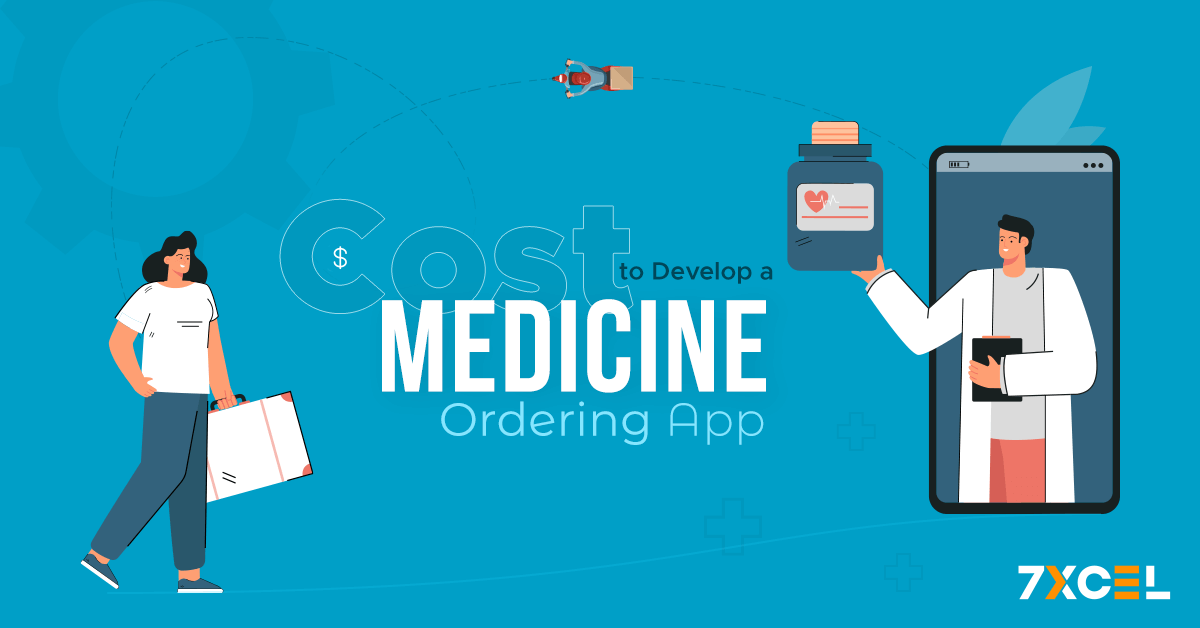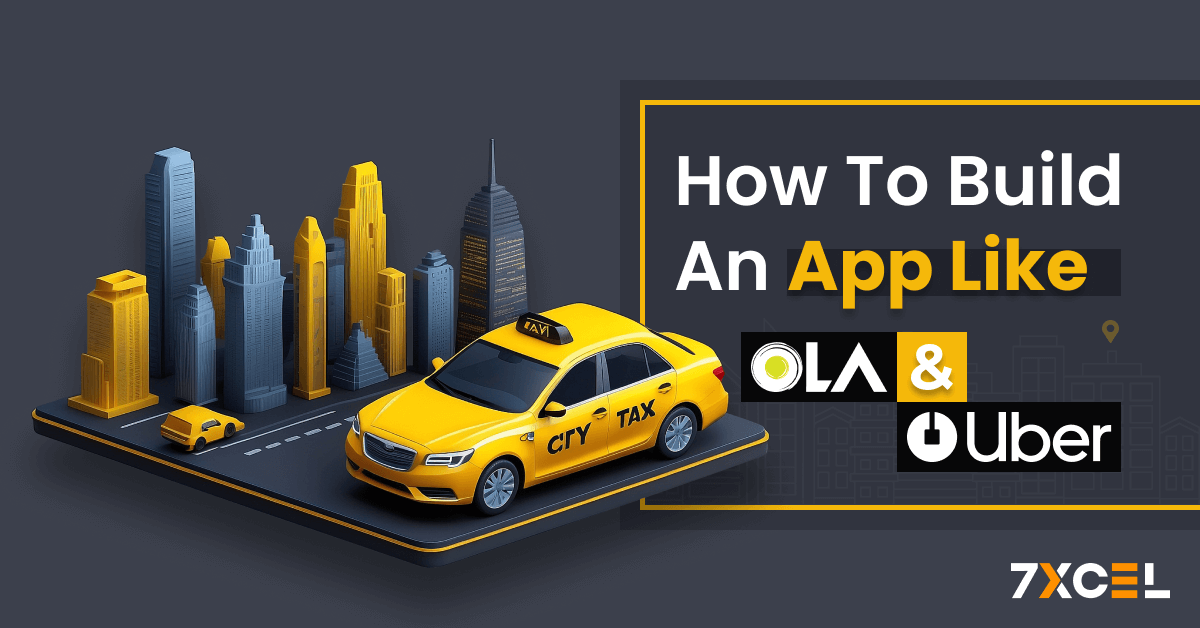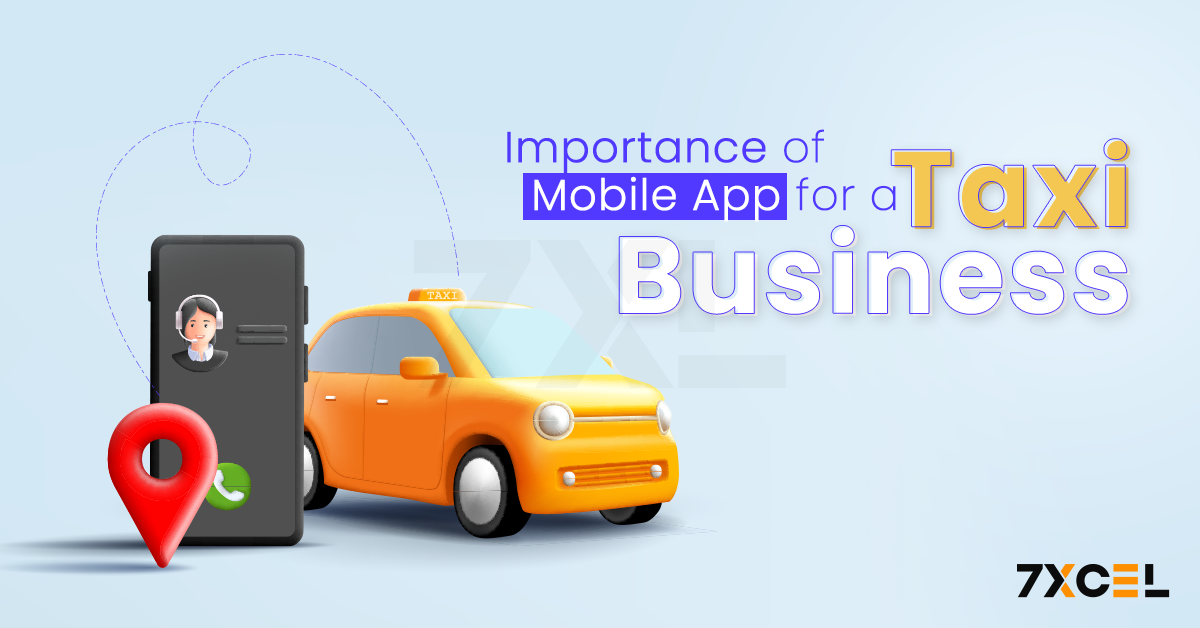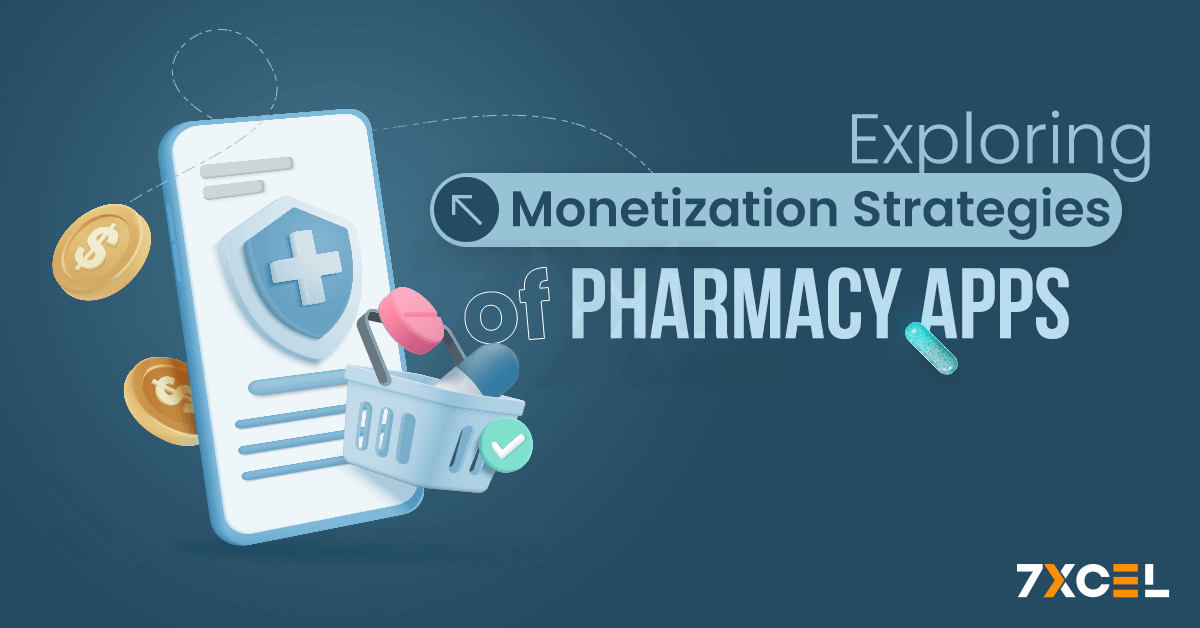Quick Summary:
Dreaming of launching an online medicine ordering app? It’s a thriving market, but building the app itself requires budgeting, this guide explores the factors affecting medicine delivery app development cost. Apart from the factors there are other things that you should keep in mind which includes features, platform choice and development team location. We’ll also delve into cost-saving strategies to help you navigate this crucial step and turn your app vision into a reality.
In this blog, we’re going to discuss📝
- Factors Influencing Medicine Delivery App Development Cost
- Features of a Successful On-Demand Medicine Delivery App
- Development Process & Cost of Medicine Delivery App
- Online Medicine Ordering App Development Process: Breakdown of Costs Tabular Form
- How Much Does It Cost To Develop an Online Medicine Delivery App?
The healthcare landscape is undergoing a digital revolution, and online medicine ordering apps are at the forefront. As per reports, the market is predicted to generate an astounding US$52.51 billion in sales by 2024, indicating the growing desire for easy access to pharmaceuticals, gone are the days of standing in huge lineups at pharmacies.
But for aspiring entrepreneurs, a key question arises: how much does an online medicine delivery app development cost? This comprehensive guide delves into the cost considerations to provide you with the knowledge needed to make informed decisions & navigate the path toward launching your successful healthcare app.
Factors Influencing Medicine Delivery App Development Cost
Developing an online medicine delivery app involves several critical factors that influence the overall cost. Here’s a breakdown of these factors:
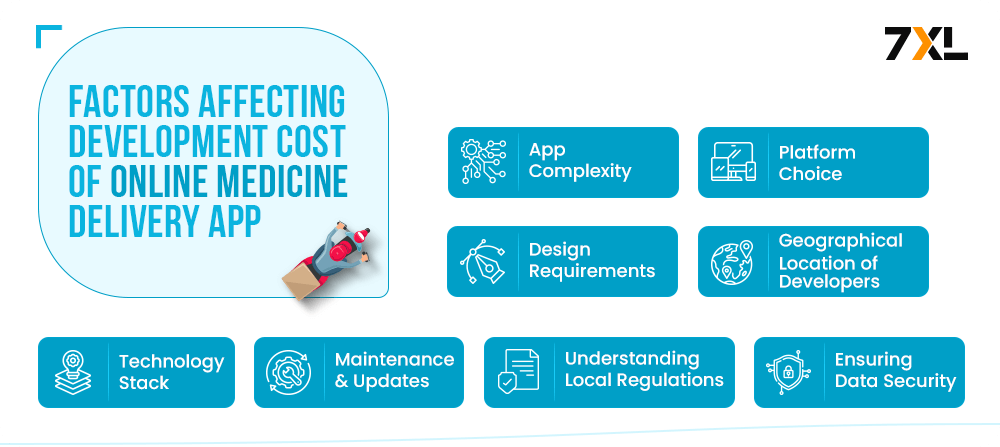
1. App Complexity
The complexity of the app is a primary factor that impacts medicine delivery app development cost. The more features and functionalities you include, the higher the cost. Here’s what to consider:
- User Interface (UI) and User Experience (UX): A sophisticated UI/UX design that is user-friendly and visually appealing will cost more. Complex navigation and interactive elements increase both design and development efforts.
- Core Features: Basic functionalities like user login, medicine search, order placement, and payment integration are essential and form the foundation of the app.
- Advanced Features: Features such as prescription uploads, in-app chat with pharmacists, real-time order tracking, and personalized health tips add complexity and increase costs.
- Admin Panel: A robust admin panel for managing orders, inventory, users, and compliance with healthcare regulations is necessary and varies in cost based on the required functionalities.
- Third-Party Integrations: Integrating APIs for payment gateways, prescription verification, and healthcare databases adds to the complexity and cost.
2. Platform Choice
The choice of platform significantly affects medicine delivery app development costs. You can choose to develop any of the app including: a native app, a cross-platform app, or a web-based app, each with different cost implications:
- Native Development: Developing separate apps for iOS and Android involves using different technologies and results in higher costs.
- Cross-Platform Development: Using frameworks like React Native or Flutter allows you to develop a single app that works on both platforms, reducing costs and time.
- Web Application: Developing a web-based app adds to the overall cost but provides broader accessibility.
3. Design Requirements
Design is an important element for user engagement & satisfaction, and more complex designs generally cost more. Key considerations include:
- Custom Design: Custom animations, high-quality graphics, and unique layouts increase the cost but enhance user experience.
- Responsive Design: Ensuring the app works well on various devices and screen sizes involves additional design work.
- Intuitive Navigation: Creating a seamless user experience with easy-to-navigate menus and clear calls-to-action can increase design costs.
4. Geographical Location of Developers
The location of a developer can have a significant impact on the cost of employment. Development costs in regions like North America and Western Europe are significantly higher compared to South Asia or Eastern Europe.
- High-Cost Regions: Developers in North America or Western Europe charge more, reflecting the higher cost of living and demand for tech talent.
- Cost-Effective Regions: Countries in South Asia or Eastern Europe offer competitive rates for skilled developers, which can help reduce overall costs.
| Region | Ballpark Price Range (USD) |
| North America | $100,000 – $500,000+ |
| Latin America | $70,000 – $300,000 |
| Western Europe | $80,000 – $400,000 |
| Eastern Europe | $50,000 – $250,000 |
| South Asia | $30,000 – $150,000 |
5. Technology Stack
The technology stack used for development influences the cost. The choice of programming languages, frameworks, & third-party services impacts both the initial and ongoing costs:
- Backend Development: Using robust frameworks like Django, Node.js, or Spring Boot can provide scalability and performance but may increase costs.
- Frontend Development: Selecting technologies like React Native or Flutter for cross-platform development helps reduce costs.
- Database Choices: Relational databases like MySQL or NoSQL options like MongoDB offer different levels of flexibility and cost implications.
- API Integrations: Integrating third-party services like payment gateways, GPS for delivery tracking, and healthcare databases increases the development cost.
| Component | Technology | Description |
| Frontend Development | React Native, Flutter | Cross-platform frameworks for mobile app development. |
| Backend Development | Django, Node.js, Spring Boot | Robust back-end frameworks for scalability and performance. |
| Databases | MySQL, MongoDB | Options for structured and unstructured data management. |
| APIs | Stripe, PayPal, Google Maps | Third-party services for payments and location services. |
| Cloud Services | AWS, Google Cloud, Azure | Scalable and reliable hosting solutions. |
6. Regulatory Compliance and Security
Ensuring compliance with healthcare regulations and implementing robust security measures can significantly impact medicine delivery app development costs:
- Compliance: Adhering to regulations like HIPAA in the U.S. requires secure data handling and storage, adding to costs.
- Security: Implementing strong encryption, secure authentication, and regular security audits are necessary to protect sensitive health data.
7. Maintenance and Updates
Post-launch maintenance is crucial for the app’s ongoing success. Periodic updates, bug fixes, & adding new features ensure the app remains competitive and functional:
- Maintenance: Involves fixing bugs, optimizing performance, and ensuring security.
- Updates: Keeping the application up to date with the newest operating system versions and frequently adding new features will give the application an competitive edge.
| Maintenance | Description | Cost Implications (USD) |
| Bug Fixes | Address user-reported issues | $2,000 – $5,000/month |
| Updates | Adding new features and OS compatibility | $5,000 – $15,000 per update cycle |
| User Support | Providing ongoing customer support | $2,000 – $8,000/month |
By considering these factors, you can plan effectively and manage the costs involved in developing an online medicine delivery app. Partnering with a specialized Medicine Delivery App Development Company can help you build a robust and user-friendly platform.
They can assist in making strategic choices in platform, technology stack, and development region, ensuring the app meets regulatory requirements and offers features like real-time tracking and secure payment options. Proper planning and expert guidance can lead to a cost-effective and successful app launch.
Essential Features of a Successful Online Medicine Ordering App
Creating a successful online medicine ordering app requires incorporating features that address user needs and ensure a seamless experience. Below are the essential medicine delivery app development cost and their features considerations:
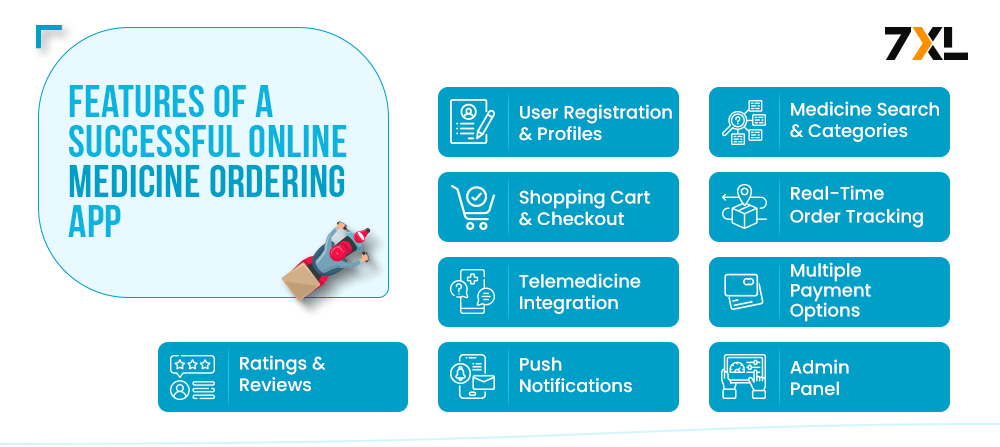
1. User Registration and Profiles
An simpler registration process is important, allowing users to log in using email, phone, or social media accounts. User profiles store important information such as medical history, prescription records, and preferred payment methods, providing a personalized experience and facilitating easier repeat orders.
Cost Considerations:
Developing this feature typically costs between $2,000 and $5,000, depending on the complexity of data storage and integration.
2. Medicine Search and Categories
An efficient search function and well-organized categories enable users to quickly find the medicines they need. Advanced search features might include filters for medicine type, brand, price, and availability, enhancing user convenience and experience.
Cost Considerations:
Implementing a robust search functionality and detailed categorization usually costs between $3,000 and $8,000.
3. Shopping Cart and Checkout
A secure and seamless checkout process is critical for user retention. This includes multiple payment options like digital wallets, credit/debit cards, and cash on delivery. Features like order review, discount code application, and delivery slot selection enhance the user experience.
Cost Considerations:
Development costs for a comprehensive shopping cart and checkout system typically range from $5,000 to $15,000.
4. Real-Time Order Tracking
Real-time tracking allows users to monitor their order status from purchase to delivery. This feature includes GPS tracking of the delivery person, estimated delivery time, and push notifications for updates.
Cost Considerations:
Developing real-time order tracking functionality generally costs between $7,000 and $15,000.
5. Telemedicine Integration
Integrating telemedicine features enables users to consult with healthcare professionals directly through the app. This can include video consultations, chat options, and access to medical advice, which enhances the app’s value proposition.
Cost Considerations:
Adding telemedicine capabilities can cost between $10,000 and $20,000, depending on the complexity and integration with healthcare systems.
6. Multiple Payment Options
Supporting multiple payment gateways increases convenience and accessibility for users. Options should include digital wallets, bank transfers, and major credit/debit cards, ensuring users can choose their preferred payment method.
Cost Considerations:
The cost for integrating multiple payment options ranges from $3,000 to $10,000.
7. Ratings and Reviews
Allowing users to rate and review medicines and services helps build trust and provides valuable feedback. This feature encourages transparency and helps other users make informed decisions.
Cost Considerations:
Developing a ratings and reviews system typically costs between $2,000 and $5,000.
8. Push Notifications
Push notifications keep users informed about order confirmations, delivery updates, promotional offers, and reminders for reordering medicines. They are an effective way to enhance user engagement and retention.
Cost Considerations:
Implementing push notifications generally costs between $1,000 and $3,000.
9. Admin Panel
An admin panel is essential for managing backend tasks such as order processing, controlling inventory, & customer support. A robust admin panel helps streamline operations and maintain smooth app functionality.
Cost Considerations:
The cost for developing a comprehensive admin panel ranges in between $5,000 to $20,000, depending on the app complexity and features required.
| Feature | Description | Cost Considerations (USD) |
| User Registration and Profiles | Simple registration with options for email, phone, or social media logins. Stores medical history and prescription records. | $2,000 – $5,000 |
| Medicine Search and Categories | Efficient search with filters and well-organized categories for quick retrieval. | $3,000 – $8,000 |
| Shopping Cart and Checkout | Secure checkout with multiple payment options, order review, and delivery slot selection. | $5,000 – $15,000 |
| Real-Time Order Tracking | Provides order status updates, GPS tracking, and notifications. | $7,000 – $15,000 |
| Telemedicine Integration | Enables video consultations and medical advice through the app. | $10,000 – $20,000 |
| Multiple Payment Options | Supports various payment methods for user convenience. | $3,000 – $10,000 |
| Ratings and Reviews | Allows users to rate and review products and services. | $2,000 – $5,000 |
| Push Notifications | Sends updates on orders, promotions, and reminders through push notifications. | $1,000 – $3,000 |
| Admin Panel | Manages backend operations such as inventory and order processing. | $5,000 – $20,000 |
This comprehensive list of features and cost considerations offers a detailed overview of the essential elements needed to develop a successful online medicine ordering app. Each of these feature plays a vital role in ensuring user satisfaction and app functionality, with associated costs varying based on the complexity and scope of development.
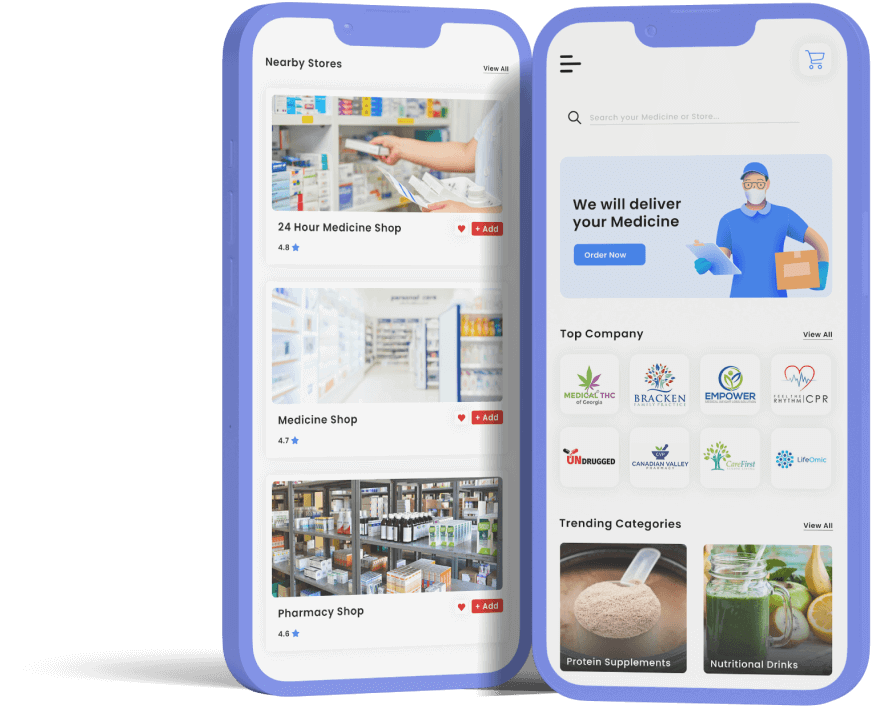
Ready to prescribe convenience right to your customers’ doors?
Boost your medicine delivery business with 7xcel’s cutting-edge app development, & Empower patients with the tap of a button – your pharmacy, their pocket.
Development Process and Costs of Online Medicine Delivery
Creating a successful on-demand medicine delivery app involves multiple critical stages, each with associated costs that need to be carefully managed. Here’s a detailed breakdown of each development stage and the typical costs involved:
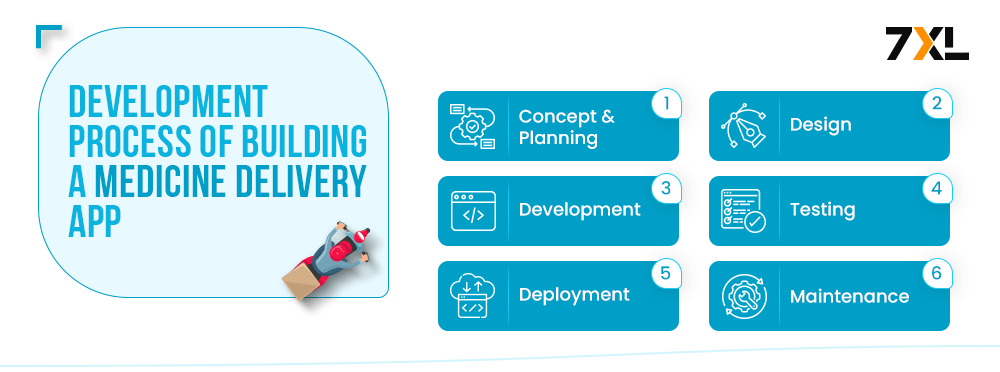
1. Concept and Planning
Outlining the main features, determining the target user base, and defining the app’s purpose are all part of the first phase. This stage involves competition analysis to find possibilities and threats as well as extensive market research to understand user demands.
Activities Include:
- Defining app objectives and features.
- Conducting market research and competitive analysis.
- Developing a detailed project plan with timelines and budgets.
Cost Considerations:
Costs for market research and initial planning typically falls in between $5,000 to $10,000, depending on the depth of research and analysis required.
2. Design
This stage focuses on creating wireframes, prototypes, and detailed UI/UX designs. It aims to visualize the app’s user interface and user experience, ensuring it is intuitive and user-friendly.
Activities Include:
- Wire framing: Outlining the app structure and flow.
- Prototyping: Building interactive prototypes to test functionality and user experience.
- UI/UX Design: Crafting detailed and visually appealing interfaces.
Cost Considerations:
- Wireframing: $1,000 to $3,000.
- Prototyping: $2,000 to $5,000.
- UI/UX Design: $5,000 to $15,000.
3. Development
The development phase involves coding the app, integrating APIs, and setting up the backend infrastructure. This stage is where the app’s functionalities are brought to life through programming.
Activities Include:
- Frontend Development: Creating the user interface and integrating it with backend services.
- Backend Development: Setting up servers, databases, and application logic.
- API Integration: Connecting the app with third-party services such as payment gateways and prescription verification systems.
Cost Considerations:
- Frontend Development: $10,000 to $30,000.
- Backend Development: $15,000 to $40,000.
- API Integration: $3,000 to $10,000.
4. Testing
To make sure the software works smoothly, is free of bugs, and offers a flawless user experience, testing is essential. To confirm functionality and performance under varied circumstances, several testing methodologies are used.
Activities Include:
- Unit Testing: Testing individual components for functionality.
- Integration Testing: Ensuring different app modules work together seamlessly.
- Performance Testing: Assessing the app’s speed, responsiveness, and stability.
- User Acceptance Testing (UAT): Gathering feedback from real users to ensure the app meets their needs and expectations.
Cost Considerations:
- Unit Testing: $1,000 to $5,000.
- Integration Testing: $2,000 to $7,000.
- Performance Testing: $3,000 to $10,000.
- User Acceptance Testing (UAT): $2,000 to $8,000.
5. Deployment
Deployment involves preparing the app for launch, including submission to app stores and planning marketing strategies to attract users.
Activities Include:
- App Store Submission: Preparing & offering the app for review on platforms like Google Play and the Apple App Store.
- Launching the App: Marketing efforts to promote the app and attract users, including creating promotional materials and setting up launch events.
Cost Considerations:
App Store Submission: $1,000 to $3,000.
Launching the App: $5,000 to $20,000, depending on the scale of promotional activities.
6. Maintenance
Post-launch maintenance ensures the app remains functional, up-to-date, and continues to meet user needs. This involves regular updates, bug fixes, and customer support.
Activities Include:
- Bug Fixes: Continuously addressing and resolving issues reported by users.
- Regular Updates: Adding new features and ensuring compatibility with the latest OS versions.
- User Support: Providing ongoing assistance and support to users.
Cost Considerations:
Maintenance costs generally falls in the range of $2,000 to $5,000 per month, based on the app’s complexity and user base.
Online Medicine Delivery App Development Process: Breakdown of Costs Tabular Form
| Stage | Description | Activities | Cost Considerations |
| Concept & Planning | Define app goals, target audience, features, and create a project plan. | $5,000 – $10,000 | |
| Design | Create wireframes, prototypes, and UI/UX designs. | ✮ Wireframing: App structure and flow. ✮ Prototyping: Interactive mockups. ✮ UI/UX Design: Detailed interfaces. |
✮ Wireframing: $1,000 – $3,000. ✮ Prototyping: $2,000 – $5,000. ✮ UI/UX Design: $5,000 – $15,000. |
| Development | Code the app, integrate APIs, and set up the backend. | ✮ Frontend Development: User interface and backend integration. ✮ Backend Development: Servers, databases, and logic. ✮ API Integration: Third-party services (payment, prescription verification). |
✮ Frontend Development: $10,000 – $30,000. ✮ Backend Development: $15,000 – $40,000. ✮ API Integration: $3,000 – $10,000. |
| Testing | Ensure app functionality and performance. | ✮ Unit Testing: Individual components. ✮ Integration Testing: Different app modules working together. ✮ Performance Testing: Speed, responsiveness, and stability. ✮ User Acceptance Testing (UAT): Real user feedback. |
✮ Unit Testing: $1,000 – $5,000. ✮ Integration Testing: $2,000 – $7,000. ✮ Performance Testing: $3,000 – $10,000. ✮ User Acceptance Testing (UAT): $2,000 – $8,000. |
| Deployment | Prepare the app for launch and market it. | ✮ App Store Submission: Submitting the app for review (Google Play, App Store). ✮ Launching the App: Marketing and promotional activities. |
✮ App Store Submission: $1,000 – $3,000. ✮ Launching the App: $5,000 – $20,000. |
| Maintenance | Ongoing updates, bug fixes, and user support. | ✮ Bug Fixes: Addressing user-reported issues. ✮ Regular Updates: New features and OS compatibility. ✮ User Support: Ongoing assistance to users. |
✮ $2,000 – $5,000 per month (depending on complexity and user base). |
How Much Does It Cost To Develop an Online Medicine Delivery App?
Depending on the app’s complexity, the whole process of its development in regard to online medicine ordering varies in time and cost. A detailed estimation includes such parts as the basic, medium complexity, and highly complex features, with a rough figure of the estimated timeline in which such an app shall be developed are given below:
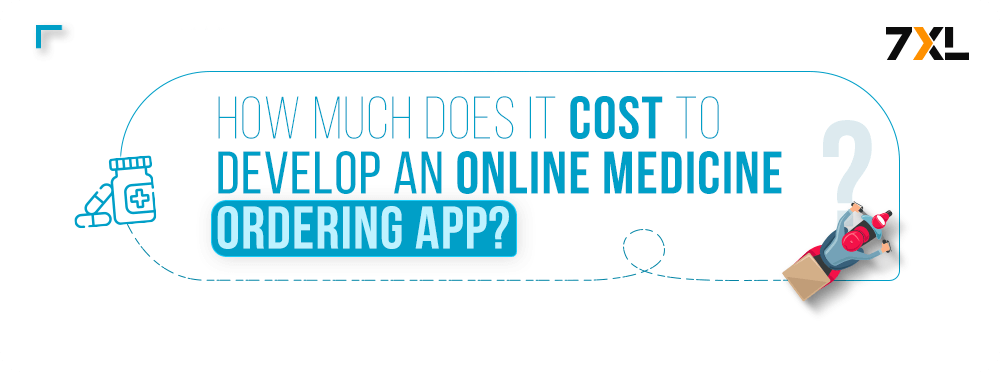
Basic App: $15,000 to $25,000
The basic application generally would be having the key features that would be necessary for looking for medicines, uploading prescriptions, making payments, and tracking an order. User interfaces are designed to make them highly accessible.
Features
- User Interface: User-friendly, easy, and intuitive.
- Basic Medicine Catalog: A small collection of medicines with relevant information.
- Prescription Upload: Easy way for the user to upload their prescription.
- Secure Payments: Integrates with popular payment gateways.
- Track Order: Basic order status reporting.
- Customer Support: Basic customer service can be maintained via email or phone.
Estimated Timeline: 3-6 months
Estimated Cost Breakdown:
- User Interface Design: $3,000 – $5,000
- Medicine Catalog: $2,000 – $3,000
- Prescription Upload: $3,000 – $4,000
- Secure Payments: $3,000 – $5,000
- Order Tracking: $2,000 – $3,000
- Customer Support: $2,000 – $3,000
- Total Cost: $15,000 to $25,000
Medium Complexity App: $25,000 to $40,000
A medium-complexity app combines advanced sets of added features with extended functionality, such as detailed order tracking, a comprehensive medicine catalog, and extended customer support. The functionality of the app is also very much enhanced, and the user experience will be really nice with these additional features.
Features
- User Interface: New layout and a more user-friendly design.
- Full Medicine Catalog: Very detailed Medicine catalog.
- Prescription Upload and Verification: A very high-security level prescription verification system.
- The Most Advanced Secure Payments: Integration with multiple payment gateways, with digital wallets.
- Order Tracking: Tracking of Order in real time, detailed tracking, and notifications.
- Customer Service and Feedback: Chat support along with a feedback system.
- Refill Prescription Reminders: Prescription refill automated reminders.
Estimated Timeline: 6-9 months
Estimated Cost Breakdown
- User Interface Design: $5,000 – $8,000
- Comprehensive Medicine Catalog: $3,000 – $5,000
- Prescription Upload and Verification: $4,000 – $6,000
- Advanced Secure Payments: $4,000 – $6,000
- Real-Time Order Tracking: $3,000 – $5,000
- Customer Support and Feedback: $3,000 – $5,000
- Prescription Refill Reminders: $3,000 – $5,000
- Total Cost: $25,000 to $40,000
Highly Complex App: $40,000 to $150,000 or more
It is a complex application with all advanced features, functioning like a complete solution in the field. Fusing telehealth services or TeleMedicine App with advanced recommendations and secure features powered by AI truly offers a robust and user-centric app.
Features:
- User-friendly interface: It is high-end in design with a friendly, intuitive interface.
- Extensive Medicine Catalog: Comprehensive catalog with detailed information and user reviews.
- Prescription Upload and Verification: Multi-layered system ensuring verification is done securely.
- Secure Payments: Easily integrate with any of the numerous internationally available payment gateways, including PayPal.
- Real-time Order Tracking: View the real-time status of your order with detailed information on GPS integrations.
- Customer Support and Feedback: Online chat support 24/7 with integrated chatbot and detailed feedback system.
- Medication refill reminders: Smart, personalized reminders.
- Telehealth Integration: Enable integration with telehealth services for online consultation.
- AI-Driven Recommendations: These are personalized recommendations that make use of medicines and user profiling.
- Robust Security: Advanced security features will include high-level encryption, data safety measures, and compliance with HIPAA.
Estimated Timeline: 9-18 months
Estimated Cost Breakdown
- User Interface Design: $10,000 – $20,000
- Extensive Medicine Catalog: $5,000 – $10,000
- Prescription Upload and Verification: $6,000 – $12,000
- Secure Payments: $5,000 – $10,000
- Real-Time Order Tracking: $5,000 – $10,000
- Customer Support and Feedback: $5,000 – $10,000
- Prescription Refill Reminders: $3,000 – $5,000
- Telehealth Integration: $10,000 – $20,000
- AI-Powered Recommendations: $10,000 – $20,000
- Advanced Security Features: $5,000 – $10,000
- Total Cost: $40,000 to $150,000 or more
Conclusion
Developing an online medicine ordering app is a significant investment that can pay off by tapping into the growing digital healthcare market. By understanding the cost factors and development process, you can make informed decisions and create a competitive app that meets user needs and regulatory standards.
If you’re ready to start your project or need more detailed information, feel free to reach out to our team. We’re here to help you navigate the complexities of app development and bring your vision to life.
